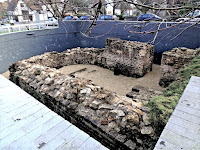When the Romans arrived in Britain in AD43 strong trading ties had existed almost since Julius Caesar's abortive invasion. Rather than seen as invaders, in many places the British tribes welcomed the Romans, as did the Corieltauvi at Lincoln. The capital city of the Corieltauvi was Leicester, it came under Roman rule in AD44 and in AD45 the Roman 9th Hispanic Legion marched northeast to Lincoln.
 |
| Newport Arch in 1793 |
The Legion had a strength of about 9,000 men who were not only soldiers but also had skills necessary for supporting an army on the move. Using these skills it is thought that they built a palisaded fort on what is now the South Common. The Witham Valley was, at that time, marsh and difficult to cross, this problem was solved by the building of a causeway nine feet above ground level, following roughly the line of Lincoln's present-day High Street.
In AD60 a fort was built on the crest of the hill on the north side of the valley and was known as Lindum. The position of this new fort gave the Romans a strategic advantage: they had an almost 180-degree view of the surrounding countryside from south-east to the north-west of the fort.
The 9th Legion (Hispana*) moved to York in AD71, the 2nd Legion occupied the fortress until about AD77. and Lindum became a Colonia in AD80, a place for veteran soldiers retired after 25 years of service, they were given a plot of land on condition they gave military service whenever required.
Lindum was of a typical Roman town design, a rectangular plan and dissected by two main roads, east-west and Ermine Street, south-north, covering an area of about 17 hectares. Bailgate roughly follows the line of Ermine Street but has been reshaped over the years by householders using the Roman road as the foundation for their properties.
 |
| Eastgate curves south after passing the remains of the Roman east gate, this may have been re-aligned by the Normans to make access to the castle easier |
 |
| Northern bastion of the Roman east gate |
 |
| A Discovery on Lincoln High Street 200 years ago. |
Lincoln was an important Roman town, the Foss Way and Ermine Street met south of the town. It was an agricultural centre the Foss Dyke was constructed between Lincoln and the River Trent at Torksey to send produce to other parts of Roman Britain.
Lindum Colonia was first surrounded by walls about 3 feet high and gates at the four points of the compass, but in the 3rd century the height of the walls was raised and substantial gates were built because of the threat of attack from the tribes of northern Europe and Scotland. Newport Arch is the only gate still existing, it was the north gate of the upper town. The west gate was buried beneath the Norman walls of the castle, and in 1836 it was re-discovered in near perfect condition but had to be reburied because the weight of the wall was causing the gate to collapse. Sadly, the east and south gates were destroyed during the late 18th century.
No comments:
Post a Comment